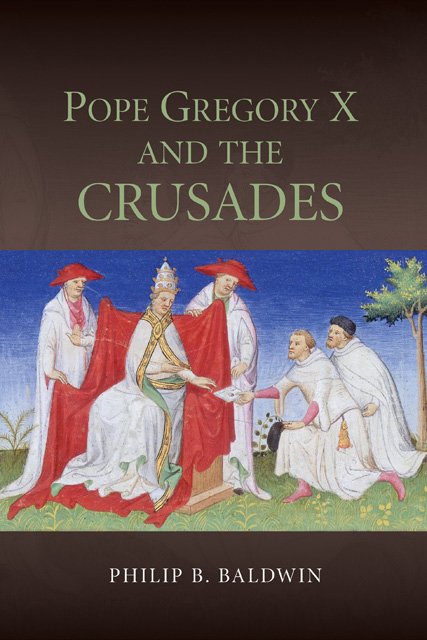Book contents
- Frontmatter
- Dedication
- Contents
- Acknowledgements
- Abbreviations
- Introduction
- 1 The Early Life of Pope Gregory X
- 2 ‘We Saw with Our Eyes and Felt with Our Very Own Hand’: The Importance of Understanding the Condition of the Holy Land
- 3 Interim Crusade Planning
- 4 A Problem of Governance? Pope Gregory X, Charles of Anjou, and the Latin Kingdom of Jerusalem
- 5 Political Exigencies and Gregory’s Crusade
- 6 Imagining Gregory’s Crusade
- Conclusion
- Bibliography
- Index
- Other Volumes in Studies in the History of Medieval Religion
- Frontmatter
- Dedication
- Contents
- Acknowledgements
- Abbreviations
- Introduction
- 1 The Early Life of Pope Gregory X
- 2 ‘We Saw with Our Eyes and Felt with Our Very Own Hand’: The Importance of Understanding the Condition of the Holy Land
- 3 Interim Crusade Planning
- 4 A Problem of Governance? Pope Gregory X, Charles of Anjou, and the Latin Kingdom of Jerusalem
- 5 Political Exigencies and Gregory’s Crusade
- 6 Imagining Gregory’s Crusade
- Conclusion
- Bibliography
- Index
- Other Volumes in Studies in the History of Medieval Religion
Summary
The papacy of Gregory X (September 1271–January 1276) stood at the very centre of the crusading movement in the later thirteenth century. Gregory was the last pope to come close to launching a traditional passagium generale to the Holy Land, and the first pope to use the passagium particulare, which would come to be the common crusading form after his death. Gregory’s crusading efforts came at a time when the Christians had never been in a worse situation since the disaster of 1187, when Saladin had succeeded in conquering essentially all the Latin kingdom of Jerusalem except Tyre, with Tripoli and Antioch remaining to the north. By Gregory’s time, the Latin kingdom of Jerusalem, now long since based in Acre, was left with only a few cities and fortresses along the littoral. Tripoli remained – just – but the principality of Antioch had been completely overrun. St Louis’ second crusade had been the last attempt at a general passage to rescue the Latin East in 1270, but it had ended in disaster with Louis’ own death in Tunis, far away from the Holy Land. The small remnants of this crusade, led by Lord Edward of England (the future Edward I), could do very little to restore Latin power in the Holy Land. Thus, Gregory’s own general passage would have been the first to reach the Holy Land since Louis’ first crusade ended in the 1250s. The intervening years had seen widespread Muslim conquest, particularly in the later 1260s.
The nature of crusading in the thirteenth century was quite different from that in the twelfth. As is well known, the very first crusaders to the Holy Land were faced with a strong but disunited enemy, and they focused their efforts on northern Syria and Palestine. Muslim unity after the First Crusade made an already formidable enemy even stronger. After the Third Crusade had succeeded in restoring Acre, but not Jerusalem, the target of subsequent crusades to the Holy Land shifted to Egypt, in the belief that Jerusalem could only be kept securely in Christian hands if it were not facing an enemy on both sides. Since Egypt was the main source of Muslim power, the Fifth Crusade and the first crusade of St Louis aimed to cut off the head to kill the body.
- Type
- Chapter
- Information
- Pope Gregory X and the Crusades , pp. 1 - 12Publisher: Boydell & BrewerPrint publication year: 2014



